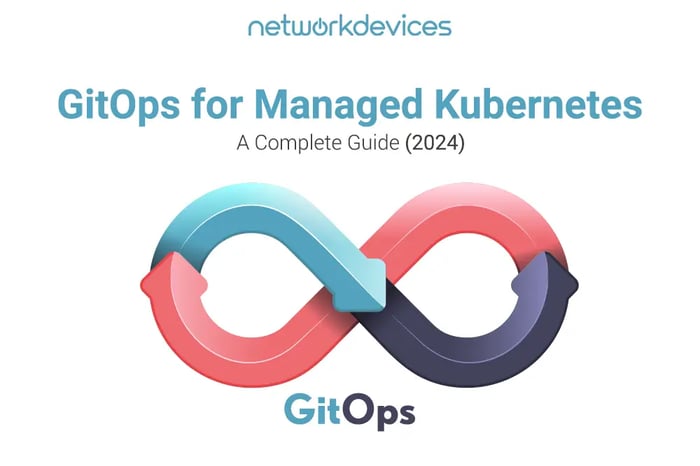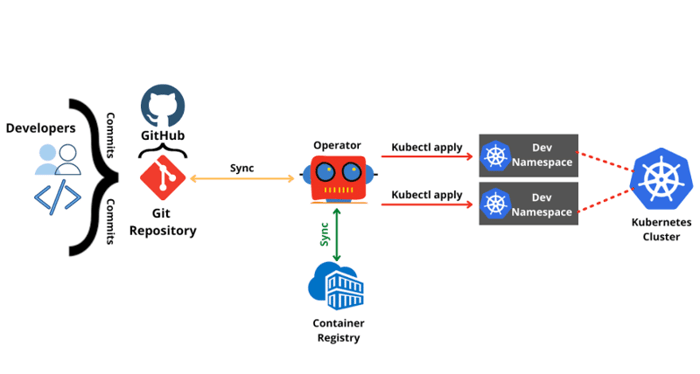You have no items in your shopping cart.

GitOps for Managed Kubernetes: A Complete Guide (2024)
Managing Kubernetes clusters, especially in managed Kubernetes environments, can be a complex task as infrastructure scales.
Traditional infrastructure management often relies on manual processes and imperative commands, leading to inconsistencies and inefficiencies.
GitOps offers a solution by using Git, a popular version control system, to automate and manage infrastructure changes. This method ensures consistent, reliable, and secure deployments, enhancing productivity and resource management.
In this guide, we’ll explore the core principles of GitOps, its benefits for Kubernetes management, and how it helps optimize Kubernetes architecture. We’ll also dive into tools and workflows that make GitOps an effective solution for modern infrastructure management.
What is GitOps?
GitOps is a set of practices that uses Git to manage Kubernetes clusters and other infrastructure.
Unlike traditional manual configurations, GitOps operates on a declarative model. This means you define the desired state of your infrastructure as code, which is stored in a Git repository. Any changes to the infrastructure are made by modifying the code and committing it to Git.

Key principles of GitOps include:
- Declarative Configuration: Define the desired system state in code, which can be audited and versioned in a Git repository. Modifications to this codebase affect infrastructure changes.
- Version Control: All changes are tracked by Git, allowing teams to easily review, approve, and roll back modifications when needed. This makes collaboration easier and more transparent.
- Automation: After changes are committed to Git, automated tools apply the changes to the live system, ensuring the infrastructure’s actual state matches the desired state.
- Immutability: Infrastructure changes must go through the Git repository, maintaining consistent, reproducible environments and preventing drift from the desired state.
Benefits of GitOps for Managed Kubernetes Environments
GitOps offers several advantages for managing Kubernetes clusters. This makes it a popular choice for many organizations.
1. Improved Collaboration
By using Git as a central repository, both development and operations teams can collaborate seamlessly. Every change is visible and traceable, allowing teams to detect and fix potential issues early.
This enhanced collaboration prevents configuration drift and keeps all teams aligned on the system’s current state.
2. Increased Developer Productivity
With GitOps, developers use familiar Git workflows, focusing more on writing code instead of handling complex deployment processes. This leads to faster development cycles and more frequent releases, increasing overall productivity.
3. Cost Optimization
GitOps helps automate resource allocation in managed Kubernetes environments, ensuring efficient use of resources. By automating scaling based on real-time demand, GitOps reduces Kube cost and prevents over-provisioning, leading to significant savings in cloud expenses.
4. Enhanced Security
GitOps strengthens security by using Git as the single source of truth. Unauthorized changes can be quickly identified and reverted, while access control measures ensure only authorized users can modify configurations.
This ensures that any unauthorized activity is detected and corrected, protecting the system’s integrity.
5. Version Control & Auditing
Since every configuration change is stored in Git, teams can easily roll back to previous versions if something goes wrong. This version-controlled approach ensures consistent configurations across different environments and creates a clear audit trail.
6. Faster Recovery from Outages
If issues arise during a deployment, GitOps makes it easy to revert to a stable configuration by rolling back to a previous version in the Git repository. This minimizes downtime and ensures that applications continue running smoothly.
GitOps Workflow for Kubernetes
The GitOps workflow for managing Kubernetes clusters is straightforward and efficient. It consists of several key components that work together to ensure smooth deployments and updates. Here is how the workflow typically functions:
1. Git Repository
The heart of GitOps is the Git repository, where all the configuration files for your Kubernetes applications are stored. These files define your application's desired state and can include settings for deployments and other resources.
2. Declarative Configuration
In GitOps, you use a declarative approach to define how your applications should run. This means you specify what the final state should look like rather than detailing each step to get there.
This makes it easier to manage changes and ensures that the actual state of the cluster matches what is in the Git repository.
3. Continuous Integration and Continuous Deployment (CI/CD)
When changes are made to the Git repository, a CI/CD pipeline is triggered. This pipeline automates the process of testing and validating the changes.
If everything checks out, the pipeline then deploys the updated configuration to the Kubernetes cluster.
4. Deployment Tools
Deployment tools, such as Argo CD or Flux, are important for GitOps workflow. These tools continuously monitor the Git repository for changes. When a change is detected, they automatically apply the new configuration to the Kubernetes cluster.
This ensures that the cluster is always in sync with the desired state defined in Git
5. Monitoring and Drift Detection
Once the deployment is complete, monitoring tools monitor the Kubernetes cluster. They check for any discrepancies between the actual state of the cluster and the desired state in Git.
If a drift is detected this means that the actual state does not match the configuration in Git. Then, the GitOps tool can automatically correct it and bring the cluster back to its intended state.
6. Rollback and Recovery
If an issue arises after a deployment, GitOps makes it easy to roll back to a previous version. You can quickly revert to a stable configuration as all changes are tracked in Git. This capability minimizes downtime and helps maintain application reliability.
This approach not only simplifies deployments but also leads to reliability and collaboration across teams.
Popular GitOps Tools for Kubernetes
Choosing the right tools is key to successfully implementing GitOps for Kubernetes management. Here are some popular options:
1. Argo CD
A tool specifically designed for GitOps, Argo CD monitors Git repositories and automatically applies changes to Kubernetes clusters. It offers a user-friendly interface and visualization tools.
2. Flux
A flexible, lightweight tool that integrates well with Kubernetes. It continuously watches the Git repository for changes and applies them to the cluster.
3. Jenkins X
Jenkins X is an extension of the Jenkins CI/CD tool, designed for Kubernetes. It incorporates GitOps principles by using Git as the source of truth for application configurations. Jenkins X automates the entire pipeline, from building and testing to deploying applications.
4. Weave GitOps
Weave GitOps is a tool that simplifies the GitOps process. It provides a straightforward way to manage Kubernetes applications using Git.
Weave GitOps integrates with existing CI/CD pipelines and offers features like monitoring and drift detection.
5. GitLab CI/CD
GitLab CI/CD platform has built-in support for GitOps, making it easy to define and automate deployments in Kubernetes directly from GitLab repositories.
Challenges When Implementing GitOps for Kubernetes
While GitOps provides a robust framework for Kubernetes management, there are some challenges organizations may face when implementing it.
- Complex Setup: Implementing GitOps requires a deep understanding of both Git and Kubernetes, along with setting up the necessary systems to integrate the two. Teams may need time to configure the tools and workflows correctly.
- Tool Selection: With a variety of tools available (such as Argo CD, Flux, and Jenkins X), organizations need to choose the one that best suits their existing tech stack and workflows. Cost management tools, such as those addressing Kube cost, should also be considered for optimizing resources.
- Cultural Shift: Adopting GitOps often requires a mindset shift within teams. Development and operations teams need to collaborate closely, which can be challenging in organizations where silos exist. The transition may take time, but it leads to long-term efficiency and stability.
Wrapping Up
GitOps is transforming how organizations manage Kubernetes clusters by introducing automation, consistency, and reliability into the deployment process.By using Git as the single source of truth and automating the application of infrastructure changes, teams can streamline operations, improve security, and reduce human error.
As more organizations adopt GitOps, they will be better positioned to handle the complexities of modern Kubernetes architecture and manage cloud resources efficiently.
Whether you’re running a large enterprise or a small startup, GitOps provides a clear, scalable path to simplifying Kubernetes management, optimizing costs, and ensuring system consistency across all environments.
If you’re interested in expanding your Kubernetes environment to support both containers and virtual machines, check out our guide on Modern Virtualization with KubeVirt. Discover how KubeVirt brings together traditional VMs and modern Kubernetes management for flexible, scalable infrastructure.






